Articles
Study Still Life Drawing
Let us consider the stages of the drawing of still life which includes several objects and drapery.
One of the most important skills you have a possibility to improve while drawing still life is the ability to convey the entire chiaroscuro.
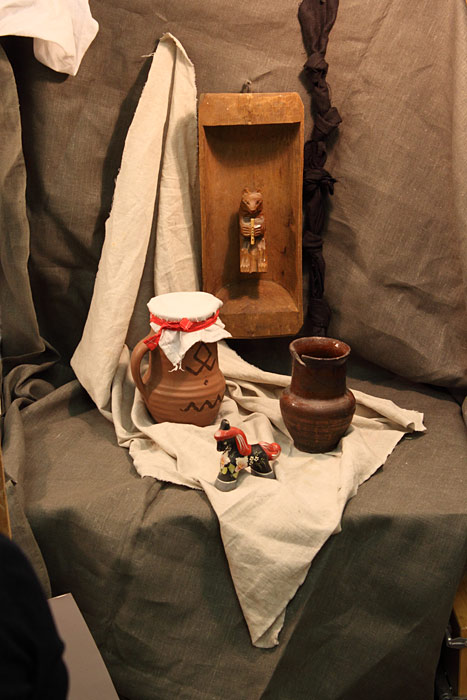
At the beginning it is relatively easier to compare the tonal relations within small areas. The thing which is really needed is the ability to abstract oneself from the concrete details (temporally not paying attention to them) and to see the entire tonal picture.
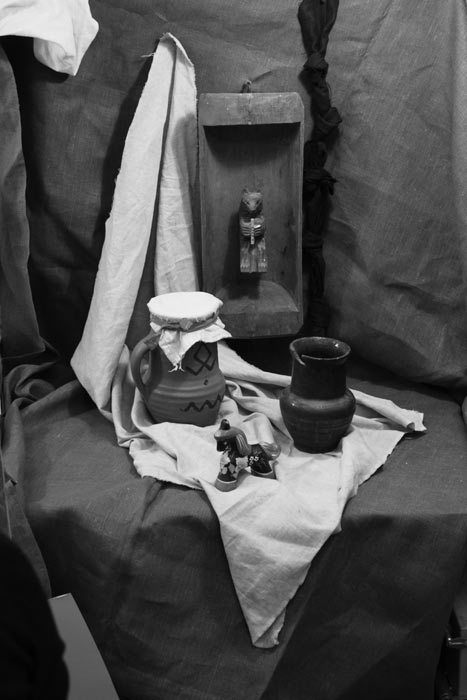
Looking at a model with defocused eyes will help you a lot to catch the main relations.

If you look at depicted objects with defocused eyes, the small details will not be visible. However, the entire tonal masses will become more clear and obvious. Thereby this technique helps us to see the main tonal relations. To look at the model this way you need to direct your eyes to something located far away. While doing this your eyes are focused on remote area and the model becomes fuzzy.
It is interesting, that there is a special term “a gaze like to the far mountains” in eastern fencing schools. It is recommended to watch an adversary using this method in order to be able to estimate the solid situation during the battle. The same advice experienced drivers would give you: while looking into the distance, it is needed to be simultaneously conscious of everything which happens next to us.
We may state, that concentrating on details and loosing control of the solid situation is a mistake in all of that different areas. While the price which is needed to be paid due to this mistake might be a life for a swordsman or a driver, painter will be
punished with an inharmonious and hollow drawing with inadequate and imprecise tonal relations.
Before starting drawing, we should make a sketch in order to find a composition. It is important to do a tonal sketch due to the fact that we are working on tonal still life. Otherwise even an ideal arrangement found in lines may turn out to be discordant and ineffectual by the end of the work.

It is preferable to not confine working on composition by copying everything what we see and framing it.
It is also highly recommended to not rest content with finding simply balanced arrangement.
Everything listed above is essential, but it is not enough.
More conscious work on composition means the search of efficient rhythm of the drawing and of the special compositional hook. What you need to find is“music” of lines and tones.
In other words, the objects which need to be arranged interact (“talk”) with each other through their locations, through the rhythms formed by the lines and the edges of these objects. All together they shape bigger lines and directions. The main purpose is to mention the relations between those big parts and to emphasize them in the work.

On the basis of the sketch delineate the composition on a paper. Make sure, that the arrangement found in a draft retains its features when shifted on a big paper. If
painter does not mind the sketch while making an outline, he or she may lose found subtleties, not talking about balance.
Meanwhile quiet often the objects become bigger than in the sketch, and the space around them, in the contrary, contracts. This is called “zooming effect”
Inexperienced artist often underestimates good composition found in a sketch. Meantime the small size of a draft enables to estimate the situation much more consciously.
Due to this it is more rational to shift the composition from the sketch attentively at the beginning. Later, when an artist obtains more experience, it will become easier for her or him to estimate the entire impression and to take the most valuable characteristics from the sketch to the work. Moreover, the composition found in a sketch will become even more expressive shifted to the bigger size.
While shifting the composition from the sketch it is more efficient to delineate the most explicit points at first (the edges of objects, draperies, table and so on)
It is better to draw them measuring by eye first, and only then check yourself more mechanically. At the beginning we may find the position of one or two points located in the centre, then a few more between the centre and the periphery. If those points are taken correctly, the whole composition is under our control.
It is essential to delineate the arrangement of the objects simultaneously everywhere on a paper. It gives us the opportunity to see how the entire composition is shifted from the sketch to the work.
On a basis of those explicit points we delineate the solid silhouettes of all objects.
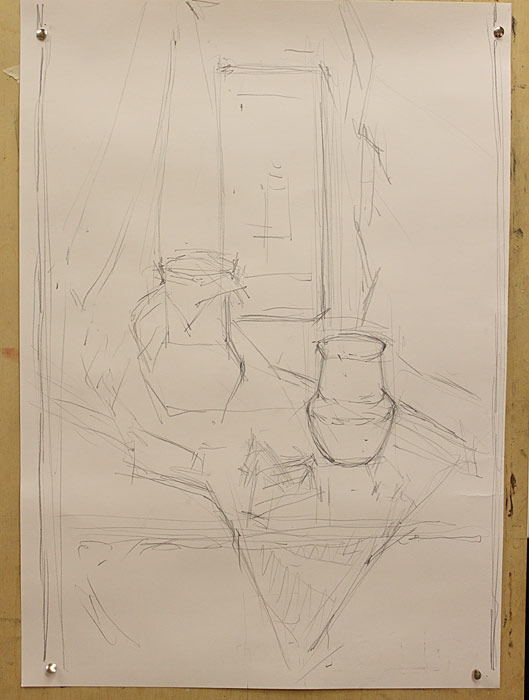
It is very important that we do not work out any detail, but only roughly delineate and dispose the objects.
Then we need to compare drawing and sketch in order to check the resemblance of the composition. If it is needed we should alter the work and check again.
This method is the most efficient for shifting the composition from the sketch.
Sometimes inexperienced painter starts to shift the composition drawing one detail, then adding another one to the previous and so on up to the moment when he or she runs out of the space on a paper. This technique does not lead to a good result because a painter has no possibility to mind the entire impression. Meanwhile, the ability to see the whole work is crucial in creating any kind of art objects. The most important purpose of doing the study drawing of still life is to develop such ability.
In addition to, drawing detail by detail, a painter will always contort the found arrangement.
When the composition on the list satisfies us, we may start to alter the main proportions and the character of the forms of objects and drapery. Then we are adding the elements of construction.
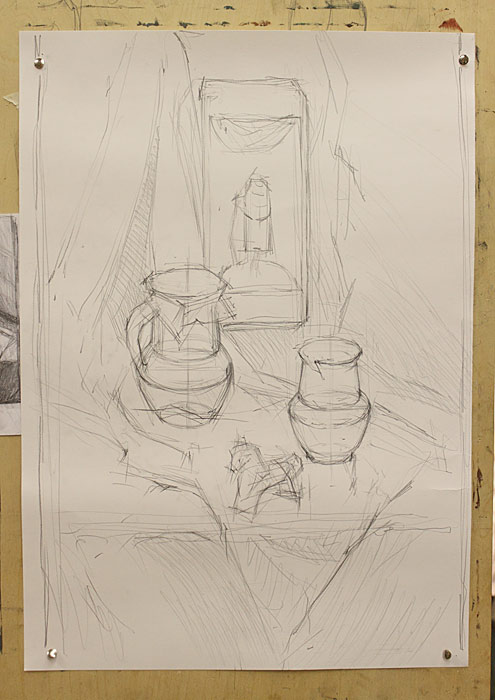
Meantime we should try to alter the work everywhere simultaneously, not working out any detail too long.
It is strongly recommended not to do drawing precise and accurate at this point. Conditions are still not sufficient for doing this.
It is better to have your sketch next to you all the time, periodically checking the entire impression and asking yourself whether you like the composition and how work looks so far.

When the proportions and the character of the form are more or less taken, you may add subtle shading.
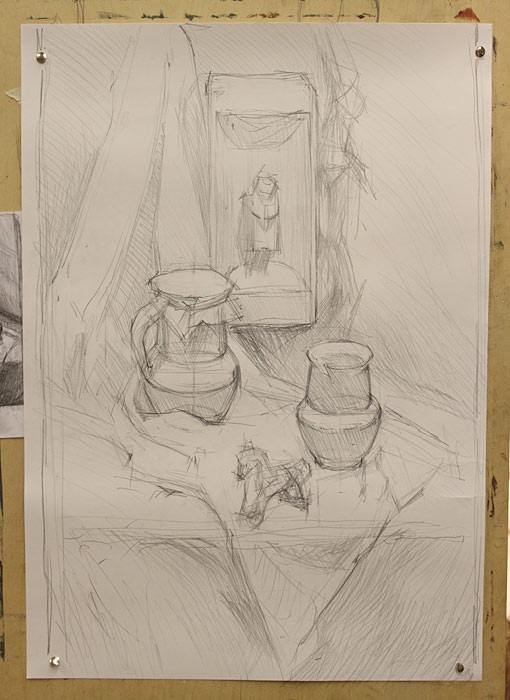
However, adding chiaroscuro, do not forget to alter the outline of the elements. In other words at this stage we are not just working on tonal relations, but keep doing the drawing more precise simultaneously with slight shading.
This method is convenient due to the fact, that in real life we almost never can see the lines which confine things around us, but areas, which may be darker or lighter.
As a result, as long as the drawing remains linear, it is difficult to check the relations between parts. We simply do not have a good possibility to compare the model with our work, due to the absence of lines in the real world.
Turning the drawing into a tonal one we finally may have a chance to check all relations and proportions. Now the mistakes, which have not been mentioned before may appear. It is easier to alter the drawing when shading remains slight and may be erased effortlessly.
Due to this there is no need to make details too dark. On the contrary, it is better to add subtle shading everywhere and keep checking the entire picture, simultaneously altering every element.
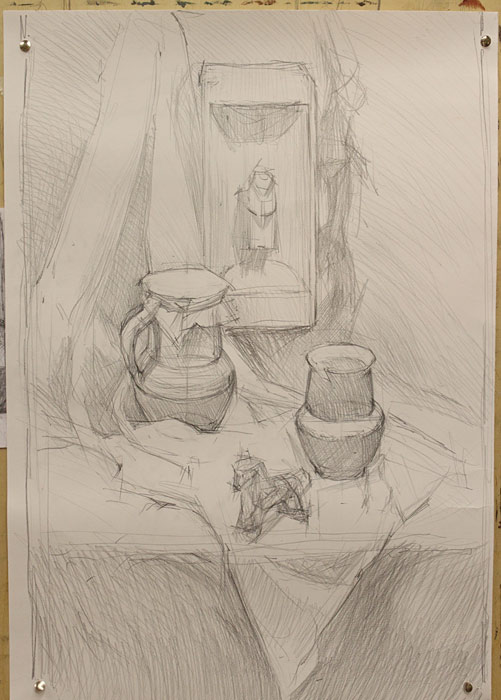
When we add slight shading, it is a good idea to look at the model like if it was lighter than it really is. Try to imagine the real tonal situation like if all areas were evenly lightened.
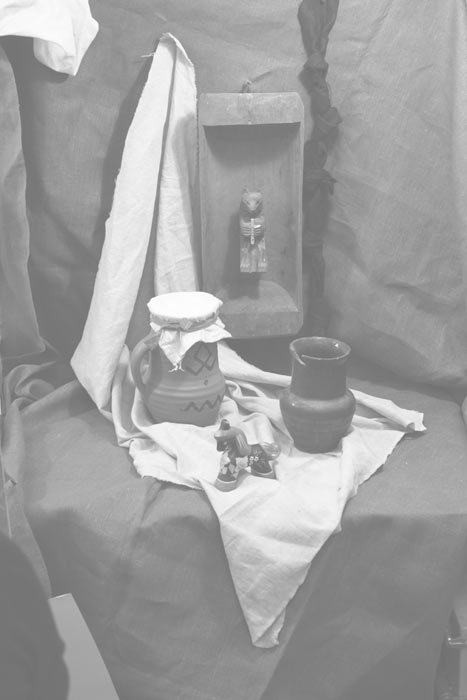
Looking at the model with defocused eyes also helps you to estimate the entire tonal
situation.
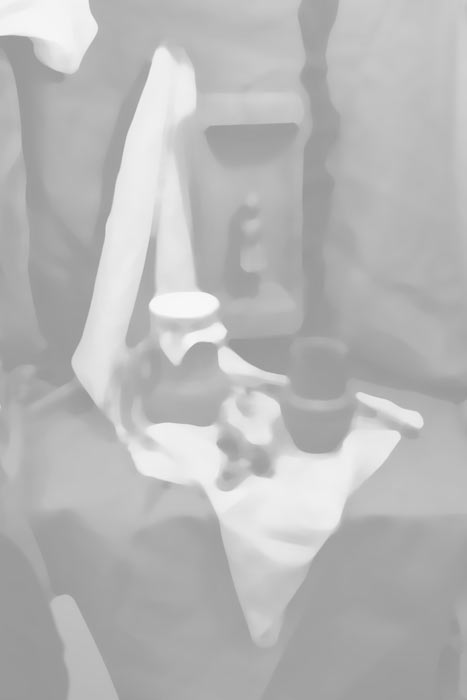
On the basis of what we saw at the distance or with defocused eyes, darken shading, frequently comparing light and dark areas.
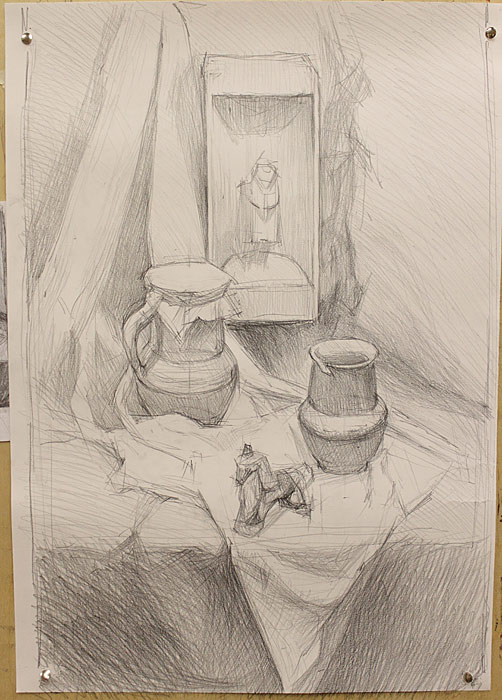
You also may look at your drawing defocusing your eyes.
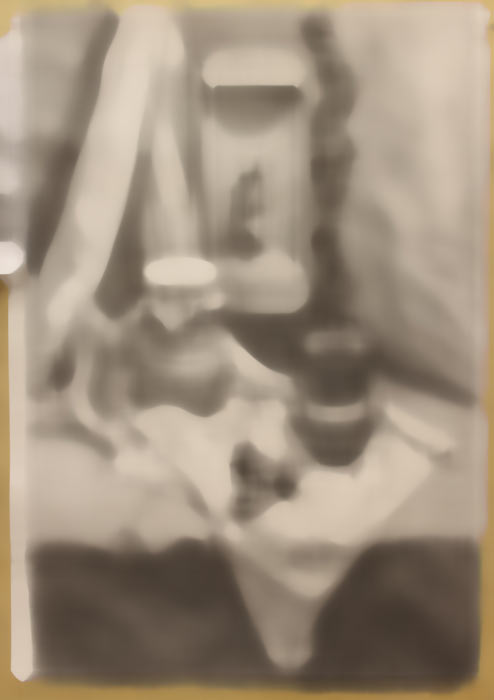
Taking the tonal relations according to the real model, it is preferable to make the elements located in the foreground more in contrast than those placed in the background. Thereby we imitate the effect of the aerial perspective.
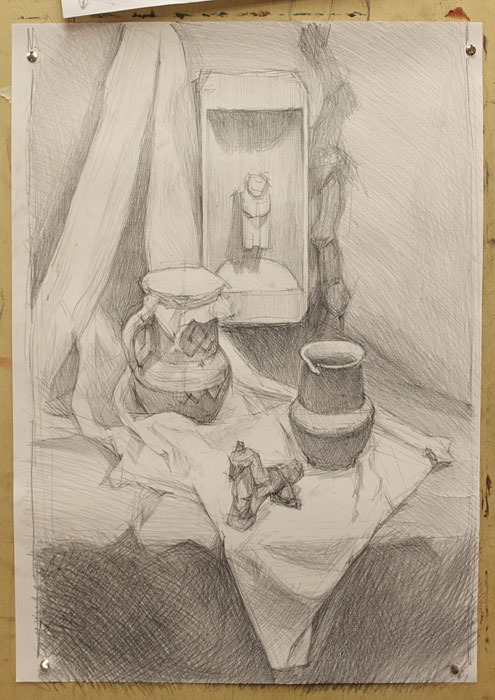
Aerial perspective helps us to convey three-dimensional space more realistically.
In real life we see the objects with two eyes which capture two slightly different pictures. Our mind joins them together in order to form an idea about the volume and the shape of the object. It is called “binocular vision”. However, the sheet of paper is flat and we may not to observe depicted objects slightly from the right with one eye and slightly from the left with another one. That’s why we add to our drawing the rules of perspective, which in real life work only for big distances, when binocular vision does not work any more. In daily life we may not see sharply the things which are placed far away from us due to the limitation of our vision and the presence of the air between us and the observed stuff.
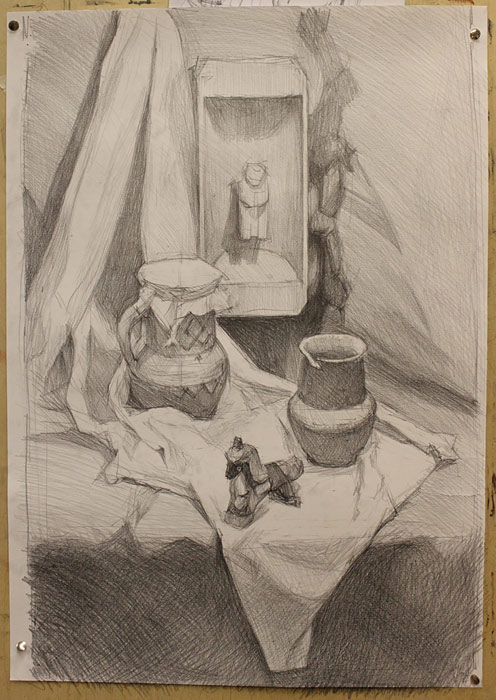

Mind aerial perspective while working out the details as well. Do not let the elements in the background become too crisp. Otherwise they will seem to be closer to us than they actually are and will destroy the sense of the realistic space. On the contrary, the detains in the foreground should be more contrast to make them look like if they were placed closer.
In general, it is recommended to not working out the details too much. It is better to check the tonal relations once more and consider the work as complete.
Oleg Toropygin
